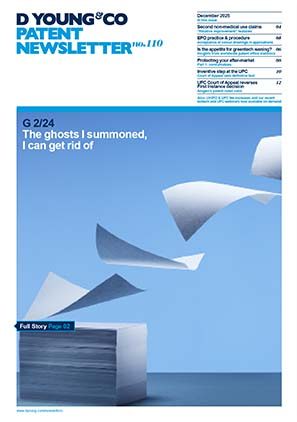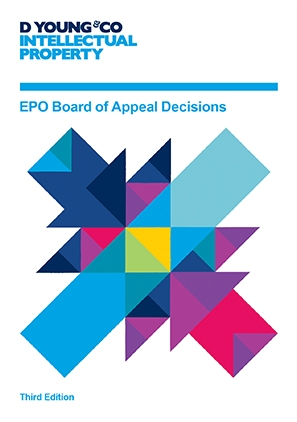G1/19: Enlarged Board of Appeal to consider the patentablity of computer-implemented inventions
For the first time in the history of the EPO, the Enlarged Board of Appeal (EBA) has been asked for a decision relating to the patentability of computer-implemented inventions (CIIs) .
Update 24 March 2021
The EPO Enlarged Board of Appeal has issued its decision in G1/19 - answers, guidance and implications.
Read moreThe present case, G1/19, stems from a referral by an EPO Board of Appeal in the case T489/14 and concerns the patentability of a computer-implemented simulation as described in EP 03793825.5, derived from WO2004023347: “MOVEMENT OF AN AUTONOMOUS ENTITY THROUGH AN ENVIRONMENT”. The web-site of the PCT applicant refers to the development of “a phenomenological model tuned to reproduce the movement of individuals in public venues hosting large crowds”. This topic has been the subject of academic study; for example, the application itself cites “Simulating dynamical features of escape panic“ by Dirk Helbing, Illis Farakas and Tamas Vicsek, Nature, volume 407, pages 487 to 490 (2000).
Claim 1 of WO2004023347 recites the following:
1. A method of simulating movement of an autonomous entity through an environment, the method comprising:
*providing a provisional path through a model of the environment from a current location to an intended destination;
*providing a profile for said autonomous entity;
*determining a preferred step towards said intended destination based upon said profile and said provisional path;
*determining a personal space around said autonomous entity;
*determining whether said preferred step is feasible by considering whether obstructions infringe said personal space.
The “autonomous entity” is typically a pedestrian whose planned route (preferred step towards the destination) might, for example, conflict with the path of another pedestrian so as to infringe the personal space of the former.
This claim was amended during prosecution to specify that the simulation is computer-implemented and by the addition of further details relating to the simulation method. The former amendment is significant in view of the “narrow interpretation” of the subject matter exclusions of Article 52(2) EPC. In particular, it is established EPO practice that if a claim has at least one technical feature (such as a computer implementation), the claim necessarily avoids the exclusions of Article 52(2) EPC.
However, as set out in Duns Licensing (T154/04) and other similar decisions, there is still a requirement for technicality as part of Article 56 EPC (inventive step). In particular, only features which contribute to the solution of a technical problem are to be considered under Article 56 EPC; non-technical features which do not so contribute are disregarded for inventive step (irrespective of how clever or non-obvious such features might be). The rationale behind this approach is that the patent system is intended for innovations in technology, rather than for innovations in non-technical fields such as business methods.
The focus of the referral from T489/14 concerns whether non-technical features contribute to the solution of a technical problem, or whether such features “equivalently … bring about a technical effect”. T489/14 holds that “a technical effect requires …a direct link with physical reality, such as a change in or measurement of a physical entity”. The Board of Appeal is of the opinion that no direct link with physical reality is present in the claimed computer-implemented simulation of WO2004023347, and this conclusion would normally lead to refusal of the application.
However the applicant drew attention to another decision, T1227/05, which relates to a method for simulating 1/f noise as part of the testing of semiconductor devices by a computer-implemented simulation. T1227/05 is something of a landmark case, overturning (or at least distinguishing) an earlier decision, T0453/01 which allowed for computer modelling to be patented providing the claim also included a step of manufacturing a physical product in accordance with the computer model.
T1227/05 departed from this finding of T0453/01 to allow patentability of a computer model providing “it serves a technical purpose”. The testing of semiconductor devices with noise was held to be such a technical purpose, and was also held to provide a technical effect. T1227/05 further provides clear policy reasons for this change in approach: “simulation performs technical functions typical of modern engineering work”. The approach of T1227/05 has been widely accepted, for example, it has been incorporated into the EPO Guidelines. In addition, similar decisions have been made under national law, such as Halliburton 2011 in the UK and Logikverifikation in Germany.
The Board of Appeal in T489/14 could have reasonably distinguished over T1227/05, for example, by arguing for a difference between the physical nature of a semiconductor device and the subjective behaviour of a pedestrian, or by arguing that the claimed invention in T489/14 is not tied firmly enough to the technical purpose of designing a building (a task which T489/14 acknowledges may be technical). However, T489/14 chooses instead to argue that T1227/05 was, in effect, wrongly decided. In view of this intended departure from T1227/05, the Board of Appeal of T489/14 has therefore referred certain questions to the EBA to resolve the issue.
One suspects that T489/14 is not a ‘spur of the moment’ action, but rather a more considered step, perhaps after consultation with members of other Boards of Appeal. Certainly, technical effect seems to have played an increasing role over the past few years in appeal decisions relating to computing, and a “direct link with physical reality” would help provide a bright-line test for the presence of technical effect.
On the other hand, there is no clear statutory basis for the position set out in T489/14. Rather, there seems to be a first extrapolation of statute to introduce the requirement for technical effect, and a second extrapolation of statute to define a technical effect as necessitating a direct link with physical reality. The EBA may perhaps be cautious about departing so far from the specific wording of the European Patent Convention (EPC).
A further concern is that T489/14 fails to set out any policy arguments against the approach of T1227/05 - in sharp contrast to T1227/05 itself, which gives clear policy reasons why it is appropriate to amend the approach of T0453/01. The position of T489/14 may therefore be based primarily on legal theory, compared with the more practical reasoning of T1227/05.
A number of amicus curiae briefs have now been filed with respect to G1/19, and these are available on the EPO web-site (https://www.epo.org/law-practice/case-law-appeals/eba/pending/g1-19.html). In general, there is widespread support for T1227/05, and little (if any) support for the position of T489/14. Even the President of the EPO has made a submission generally in support of T1227/05 (which, as noted above, reflects current general practice within the EPO).
It is hard to predict the outcome of G1/19. One possibility is for the EBA to agree with T489/14 and in effect overturn the decision of T1227/05. It seems from the amicus curiae briefs that such an outcome would not be widely welcomed, and there is also the possibility that national courts might choose not to align with such an approach.
Another option would be for the EBA to accept at least some of the legal position set out in T489/14, but to adopt a broader interpretation of what represents a direct link with physical reality, thereby allowing a computer-implemented simulation to provide a technical effect. One of the early, seminal EPO decisions on computer-implemented inventions, namely Vicom (T208/84), held that images are technical objects, and an image and a simulation might be regarded as two different representations of physical reality.
The EBA might alternatively provide a more fundamental re-think of the approach to computer-implemented inventions. For example, different decisions rely on technical problem, technical solution, technical contribution, technical purpose, technical effect, technical character, technical considerations, etc. Maybe there are too many “technicals”, and we should strip back to looking for a solution to a technical problem.
Such a re-think might also consider the amendment of the EPC to incorporate wording from the WTO TRIPS agreement that patents are available for inventions in “all fields of technology”. To date, the general EPO feeling is that this amendment merely captures existing practice, and indeed T489/12 dismisses the change “not material”. However, it could be plausibly argued that once you have an invention (which is the case for any technical implementation in view of the narrow interpretation of Article 52(2) EPC), such an invention must be eligible for patent protection if it lies in a field of technology, without any other requirements relating to technicality.
The EBA decision is not expected for several months at least. Until then, there will be plenty of speculation, but we will have to wait for the decision itself to be certain.

